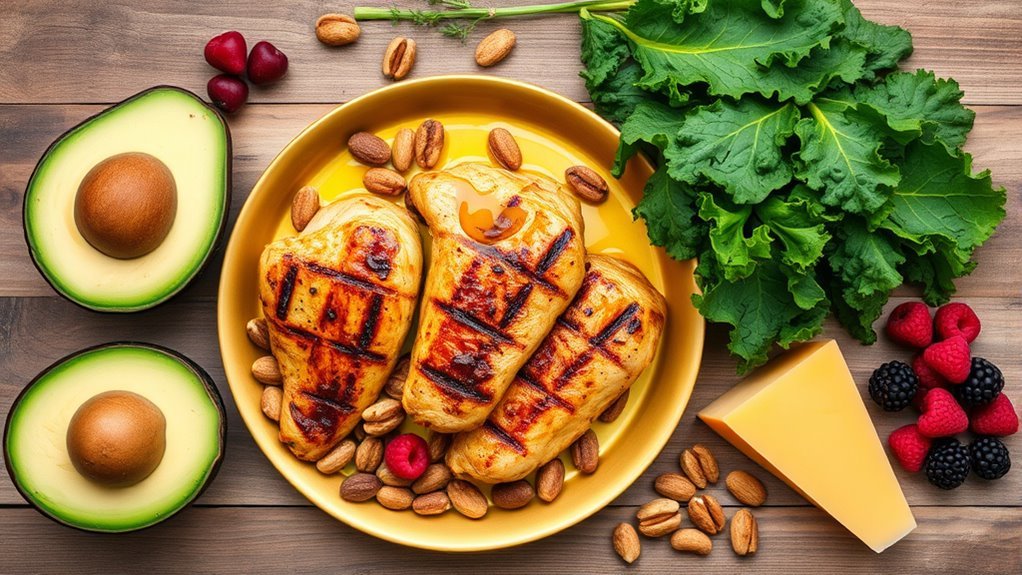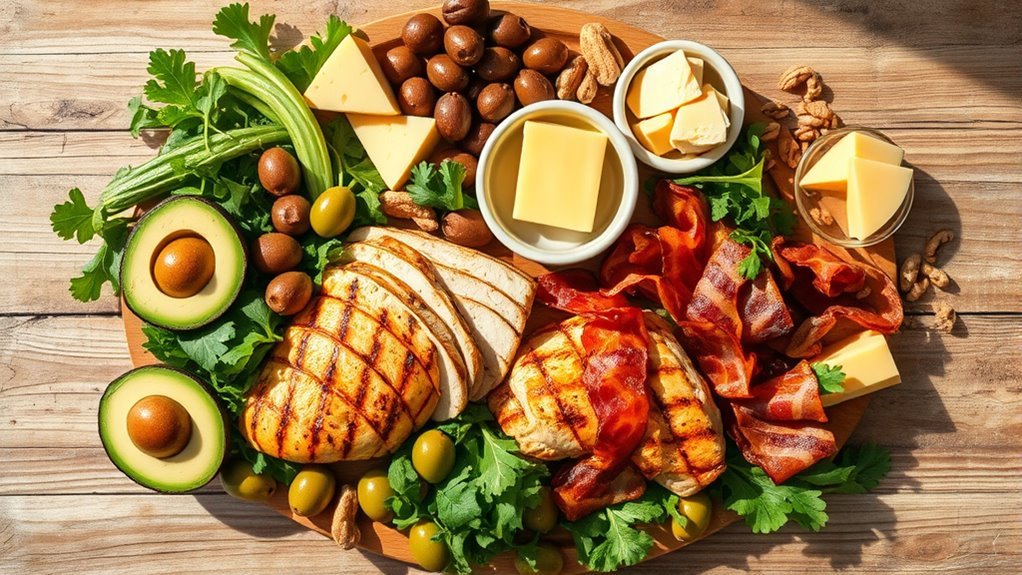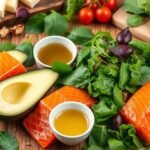The keto diet focuses on high fats, moderate proteins, and very low carbohydrates, shifting your body into ketosis to burn fat for fuel. You’ll find foods like avocados, fatty fish, nuts, and leafy greens in your meals, while avoiding processed sugars, starchy vegetables, and high-carb grains. Keeping your macronutrient ratios balanced is essential for success. By following these guidelines, you’ll discover not just weight loss benefits but also enhanced mental clarity and energy levels. More insights await!
Understanding Ketosis

When you begin the keto diet, understanding ketosis is essential to grasping how this low-carb lifestyle works. The ketosis process occurs when your body shifts from burning carbohydrates for fuel to using fat stores instead. This metabolic shift can lead to considerable weight loss and increased energy levels, which are among the key ketosis benefits. By greatly reducing your carb intake, your liver produces ketones, an alternative energy source, which helps reduce hunger and stabilize blood sugar. This change allows you to experience mental clarity and improved focus, freeing you from the energy crashes often associated with a high-carb diet. Embracing ketosis can empower you to take control of your health and achieve your goals more effectively.
Key Components of the Keto Diet

To effectively follow the keto diet, you need to understand its key components, including macronutrient ratios, as well as foods to include and avoid. Typically, the diet emphasizes high fats, moderate proteins, and very low carbohydrates to help your body enter ketosis. Knowing what to eat and what to steer clear of is essential for maximizing the benefits of this eating plan.
Macronutrient Ratios Explained
Understanding the macronutrient ratios is essential for anyone starting on the keto diet, as these ratios directly influence your body’s ability to enter and maintain ketosis. The ideal ratios typically consist of about 70-75% fat, 20-25% protein, and only 5-10% carbohydrates. This specific distribution highlights the macronutrient importance in shifting your body from glucose metabolism to fat metabolism. By focusing on high-fat intake, you’ll encourage your body to use fat as its primary energy source, which is the crux of the keto approach. Achieving these ideal ratios can be liberating, allowing you to enjoy a diverse range of foods while reaping the benefits of sustained energy and weight management. Remember, balance is key for effective results.
Foods to Include
Incorporating the right foods into your keto diet is essential for achieving and maintaining ketosis. Focus on high-fat, low-carb options to fuel your body effectively. Here are some foods to include in your meal prep:
- Avocados – Packed with healthy fats and fiber, they make a great base for many dishes.
- Nuts and Seeds – Almonds, walnuts, and chia seeds serve as excellent keto-friendly snacks.
- Leafy Greens – Spinach, kale, and arugula are nutrient-dense and low in carbs.
- Fatty Fish – Salmon and mackerel are rich in omega-3s, promoting heart health while keeping carbs low.
Foods to Avoid
While embracing a keto diet, it’s crucial to recognize which foods can hinder your progress towards ketosis. Start by avoiding processed sugars, as they can spike your insulin levels and disrupt fat burning. Starchy vegetables, like potatoes and corn, should also be limited, along with high carb grains such as rice and wheat. Sugary snacks, including candies and baked goods, are major pitfalls that can derail your efforts. You’ll want to practice legumes avoidance since they contain higher carbohydrate content. Consider fruit limits, as many fruits are sugar-rich. Additionally, steer clear of unhealthy fats, particularly trans fats, commonly found in processed foods. By avoiding these items, you’re setting yourself up for keto success and greater freedom in your dietary choices.
Foods to Include

When following a keto diet, it’s crucial to focus on high-fat foods and low-carb vegetables. Incorporating avocados, olive oil, and leafy greens not only supports your body’s shift into ketosis but also provides necessary nutrients. Understanding the right balance can help you achieve your health goals while enjoying a variety of flavors.
High-Fat Foods
To successfully follow a ketogenic diet, you’ll want to focus on incorporating a variety of high-fat foods that not only support ketosis but also provide essential nutrients. These foods can help you stay satisfied and energized while enjoying the freedom to indulge in delicious options. Here are some great choices:
- Avocados – Packed with healthy fats, fiber, and vitamins.
- Nuts and Seeds – Excellent for high fat snacks, providing protein and fiber.
- Full-Fat Dairy – Cheese, yogurt, or cream offers rich flavors and essential nutrients.
- Coconut Oil – A versatile cooking oil that can enhance keto desserts and meals.
Integrating these foods into your diet will keep you on track while satisfying your cravings.
Low-Carb Vegetables
Incorporating low-carb vegetables into your ketogenic diet is essential for maintaining nutrient density without exceeding your carbohydrate limits. Keto friendly greens like spinach, kale, and arugula are perfect options that provide essential vitamins and minerals while keeping carbs low. Cruciferous vegetables, such as broccoli and cauliflower, also fit the bill and can be used in various recipes. Zucchini and bell peppers are more low carb options that add flavor and texture to your meals. By including these vegetables, you’re not only enhancing your meals but also promoting overall health. Remember, the goal is to enjoy a variety of these nutrient-rich foods while staying within your carb limits, allowing you the freedom to thrive on your keto journey.
Foods to Avoid
Adopting a keto diet requires careful consideration of what you eat, especially when it comes to avoiding certain foods. Steering clear of specific items can help you maintain ketosis and reach your health goals. Here are four main categories to avoid:
- Processed Sugars: They spike insulin levels and derail your progress.
- High Carb Grains: Foods like bread and pasta can quickly increase your carb intake.
- Starchy Vegetables: Potatoes and corn are high in carbs and should be limited.
- Sugary Snacks: Candy and pastries are loaded with sugars and unhealthy fats.
Additionally, watch out for low-fat products, as they often contain hidden sugars, and consider avoiding artificial sweeteners and fruit juices, which can impact your keto journey.
Macronutrient Breakdown
Understanding which foods to avoid on a keto diet is just the beginning; knowing how to balance your macronutrients is equally important for success. The ideal macronutrient ratios for a standard keto diet typically consist of about 70-75% fats, 20-25% protein, and only 5-10% carbohydrates. This balance helps your body enter ketosis, where it burns fat for energy instead of carbs. Nutrient timing is also essential—consider when you consume meals to optimize energy levels and recovery. For instance, having higher protein intake post-exercise can aid muscle repair while keeping your carb intake low throughout the day. By understanding and applying these principles, you can embrace the freedom that comes with effective keto dieting.
Meal Planning Tips
Meal planning is an essential aspect of successfully following a keto diet. It helps you stay on track with your macronutrients while making grocery shopping efficient. Here are some tips to streamline your keto meal planning:
Meal planning is crucial for keto success, keeping you focused on your macros and simplifying grocery shopping.
- Plan Ahead: Set aside time each week to plan meals, focusing on low-carb ingredients.
- Use a Grocery List: Write down what you need to avoid impulse buys and guarantee you stick to keto-friendly foods.
- Batch Cook: Prepare meals in bulk to save time during the week, making it easier to maintain your diet.
- Experiment with Recipes: Explore different recipes to keep meals interesting while adhering to keto guidelines.
Snacks for the Keto Diet
While following a keto diet, finding satisfying snacks can be a game-changer for maintaining energy levels and sticking to your low-carb goals. You’ll want to focus on keto friendly snacks that are low in carbohydrates but high in healthy fats. Some quick snack ideas include avocado slices, cheese sticks, or a handful of nuts. You can also enjoy celery with cream cheese or cucumber slices topped with tuna salad. Hard-boiled eggs are another great option, providing protein and satisfying your hunger. For something sweet, consider dark chocolate with a high cocoa content. Remember, snacking on keto doesn’t have to be boring; it’s about being creative while staying within your dietary limits. Enjoy the freedom of choosing snacks that fuel your body!
Common Mistakes to Avoid
Many people plunge into the keto diet with enthusiasm, but there are common pitfalls that can derail your progress. You might fall victim to several keto misconceptions that lead to frustration. To help you stay on track, here are four mistakes to avoid:
- Neglecting Electrolytes: Low-carb diets can deplete essential minerals; make sure to replenish sodium, potassium, and magnesium.
- Overdoing Protein: Consuming too much protein can kick you out of ketosis; focus on healthy fats instead.
- Ignoring Hidden Carbs: Sauces and packaged foods may contain unexpected sugars; always read labels.
- Not Tracking Macros: Failing to monitor your fat, protein, and carb intake can hinder your results; use an app to stay accountable.
Avoid these common pitfalls to embrace a successful keto journey!
Long-term Sustainability
Achieving long-term sustainability on the keto diet requires a thoughtful approach to both eating habits and lifestyle changes. To maintain your keto lifestyle, focus on sustainable practices that promote long-term adherence. Prioritize dietary flexibility and meal variety to keep your meals enjoyable and balanced.
| Key Factors | Benefits | Considerations |
|---|---|---|
| Nutrient Balance | Supports overall health | Avoiding deficiencies |
| Social Situations | Enjoy meals with others | Plan keto-friendly options |
| Psychological Factors | Mindset for success | Address cravings and triggers |
Health Benefits of the Keto Diet
The keto diet offers several health benefits that can greatly impact your overall well-being, particularly if you’re looking to improve metabolic health or manage weight. Here are some key advantages:
- Keto Weight Loss: The diet promotes fat burning by shifting your body into ketosis, making weight loss more achievable.
- Heart Health: It may improve cholesterol levels by increasing HDL (good cholesterol) and reducing triglycerides.
- Stabilized Blood Sugar: A low-carb approach can help regulate blood sugar levels, beneficial for those with insulin resistance.
- Increased Energy: Many report enhanced energy levels and mental clarity as the body adapts to using fat for fuel.


